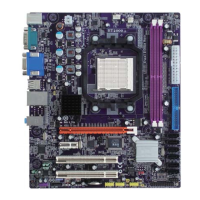34
Using BIOS
• RAS Precharge Time (tRP) (3T): This is the duration of the time interval
during which the Row Address Strobe signal to a DRAM is held low during
normal Read and Write Cycles. This is the munimum interval between com-
pleting one read or write and starting another from the same (non-page
mode) DRAM. Techniques such as memory interleaving, or use of Page Mode
DRAM are often used to avoid this delay. Some chipsets require this param-
eter in order to set up the memory configuration properly. The RAS Precharge
value is typically about the same as the RAM Access (data read/write) time.
• RAS to CAS Delay (tRCD) (3T): This is the amount of time a CAS is per-
formed after a RAS. This lower the better, but some DRAM does not support
low figures.
AGP Aperture Size
This setting controls just how much system RAM can be allocated to AGP for video
purposes. The aperture is a portion of the PCI memory address range dedicated to graphics
memory address space. Host cycles that hit the aperture range are forwarded to the AGP
without any translation.
Graphic Window WR Combin (Enabled)
This item determines whether the graphic windows base address is valid or not.
Press <Esc> to return to the Advanced Chipset Features page.
Press <Esc> to return to the Advanced Chipset Features screen.
AGP Fast Write Support (Disabled)
This item enables or disables the AGP Fast Write Support.
AGP Data Rate (Auto)
This item allows you to control AGP card transfer rate.
AGP & P2P Bridge Control (Press Enter)
Scroll to this item and press <Enter> to view the following screen:
f
AGP Aperture Size [128M]
Graphic Window WR Combin [Enabled]
AGP Fast Write Support [Disabled]
AGP Data Rate [Auto]
Phoenix-AwardBIOS CMOS Setup Utility
AGP & P2P Bridge Control
Item Help
Menu Level
ff
: Move Enter: Select +/-/PU/PD:Value F10:Save ESC:Exit F1: General Help
mnlk
F5:Previous Values F6:Fail-Safe Defaults F7:Optimized Defaults

